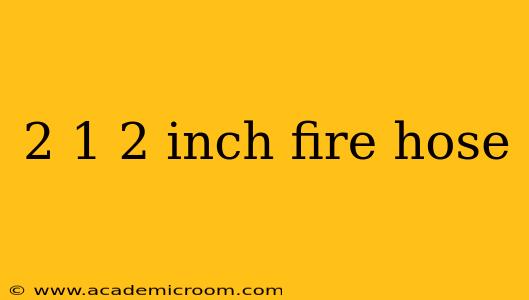Decoding the 2 1/2 Inch Fire Hose: A Comprehensive Guide
The seemingly simple description "2 1/2 inch fire hose" actually encompasses a world of specifications and applications vital to fire suppression. This guide dives deep into the intricacies of this crucial firefighting tool, answering frequently asked questions and providing valuable insights for both professionals and the curious.
What is a 2 1/2 inch fire hose used for?
A 2 1/2 inch (2.5 inch) fire hose is a workhorse in the firefighting world, predominantly used for structural firefighting. Its larger diameter allows for a higher flow rate of water, crucial for tackling significant blazes in buildings, industrial complexes, and other large structures. It's frequently used for attacking the main body of a fire, knocking down flames quickly, and providing a powerful stream for effective suppression. While smaller hoses are suitable for smaller fires or confined spaces, the 2 1/2 inch hose provides the necessary power and volume for larger-scale incidents.
What is the pressure of a 2 1/2 inch fire hose?
The pressure within a 2 1/2 inch fire hose isn't a fixed value. It varies considerably depending on several factors:
- Water source pressure: The initial pressure from the hydrant or pump significantly influences the hose pressure.
- Pump pressure: Fire engines utilize pumps to boost water pressure, enhancing the reach and force of the water stream.
- Nozzle type: Different nozzles (fog, straight stream, etc.) affect the pressure at the nozzle outlet. A fog nozzle, for example, will generally have a lower pressure at the outlet than a straight stream nozzle.
- Hose length and friction loss: Longer hose lines experience greater friction loss, reducing pressure at the nozzle.
While a precise pressure figure is impossible without specifics, a typical operating pressure range for a 2 1/2 inch hose line might be between 50 and 150 psi (pounds per square inch), but this can significantly vary based on the factors mentioned above.
What is the weight of a 2 1/2 inch fire hose?
The weight of a 2 1/2 inch fire hose isn't standardized. It depends on several variables, including:
- Hose length: A longer hose naturally weighs more.
- Hose material: Different materials (e.g., rubber, synthetic) have different densities and therefore weights.
- Lining and construction: The type of lining and overall construction influence the weight.
Therefore, providing a definitive weight is difficult without specific product information. However, it's safe to say that even a relatively short length of 2 1/2 inch fire hose can be significantly heavy, requiring multiple firefighters to handle effectively during deployment and retraction. This weight is a critical factor in training and operational safety.
How long is a 2 1/2 inch fire hose?
There's no single standard length for a 2 1/2 inch fire hose. They are typically manufactured and deployed in 50-foot sections, though they can be coupled together to create much longer lines as needed for reaching distant fire locations or providing extended reach. The overall length is dictated by the specific needs of the fire scene and the available resources.
What are the different types of 2 1/2 inch fire hoses?
2 1/2 inch fire hoses come in various types, categorized by materials and construction:
- Rubber-lined hoses: Traditional and durable, offering excellent resistance to abrasion and punctures.
- Double-jacket hoses: Featuring an inner and outer jacket for enhanced durability and protection.
- Synthetic hoses: Constructed from materials like polyester or nylon, offering lightweight and flexibility advantages but possibly less abrasion resistance than rubber.
The choice of hose type depends on factors like budget, intended use, and environmental conditions.
How much does a 2 1/2 inch fire hose cost?
The cost of a 2 1/2 inch fire hose varies greatly based on length, material, manufacturer, and any additional features (such as specialized coatings or couplings). Prices can range from several hundred dollars for a single 50-foot section to much more for longer lengths or hoses with advanced specifications.
This comprehensive guide provides a deeper understanding of the 2 1/2 inch fire hose. Remember that firehose selection and use are specialized areas requiring proper training and expertise. This information is for educational purposes only and should not be considered a substitute for professional training.
